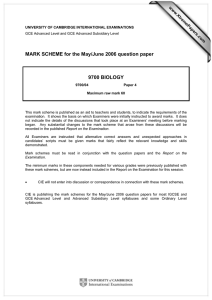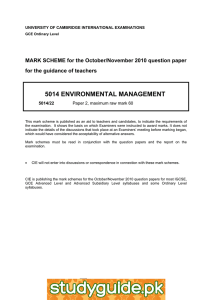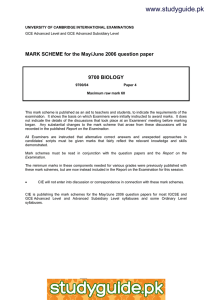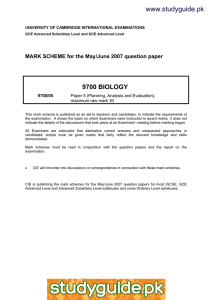9700 BIOLOGY MARK SCHEME for the May/June 2007 question paper
advertisement
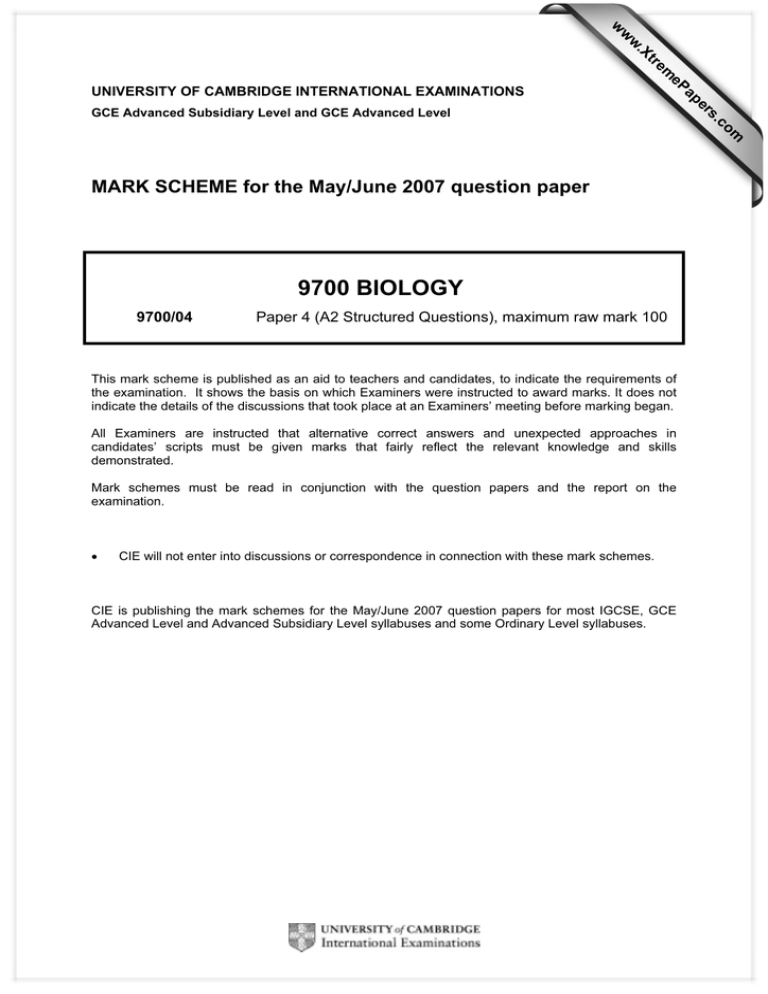
w w ap eP m e tr .X w UNIVERSITY OF CAMBRIDGE INTERNATIONAL EXAMINATIONS 9700 BIOLOGY 9700/04 Paper 4 (A2 Structured Questions), maximum raw mark 100 This mark scheme is published as an aid to teachers and candidates, to indicate the requirements of the examination. It shows the basis on which Examiners were instructed to award marks. It does not indicate the details of the discussions that took place at an Examiners’ meeting before marking began. All Examiners are instructed that alternative correct answers and unexpected approaches in candidates’ scripts must be given marks that fairly reflect the relevant knowledge and skills demonstrated. Mark schemes must be read in conjunction with the question papers and the report on the examination. • CIE will not enter into discussions or correspondence in connection with these mark schemes. CIE is publishing the mark schemes for the May/June 2007 question papers for most IGCSE, GCE Advanced Level and Advanced Subsidiary Level syllabuses and some Ordinary Level syllabuses. om .c MARK SCHEME for the May/June 2007 question paper s er GCE Advanced Subsidiary Level and GCE Advanced Level Page 2 Mark Scheme GCE A/AS LEVEL – May/June 2007 Syllabus 9700 Paper 04 Section A 1 (a) 1. killed / hunted, qualified ; e.g. for meat / for fur / blood sport / takes human food / thought to be dangerous A poaching (unqualified) 2. war ; 3. sale of live young ; 4. habitat destruction / AW ; 5. loss of / competition for food ; 6. AVP ; e.g. disease [3 max] (b) (i) 1. fewer animals need to be caught (for zoos) ; 2. ref. becoming pregnant ; e.g. IVF / finding a mate 3. reintroduction into the wild ; 4. research easier with captive animals / AW ; 5. ref. increase in numbers ; 6. ante or postnatal care ; (ii) 1. inbreeding / AW ; 2. gene pool too small ; 3. no fear of humans / difficulty in socialising with other gorillas ; 4. difficulty in, finding food / reproducing ; 5. ref. transfer of pathogens ; 6. ref. effects of captivity ; e.g. stress [3 max] [2 max] [Total: 8] 2 process major products glycolysis ATP ; pyruvate ; reduced NAD ; Krebs cycle ATP ; reduced NAD / reduced FAD ; CO2 ; oxidative phosphorylation ATP ; water ; NAD / FAD ; [8 max] R NADP throughout [Total: 8] © UCLES 2007 Page 3 3 Mark Scheme GCE A/AS LEVEL – May/June 2007 Syllabus 9700 Paper 04 (a) (i) bacterial strain A B diameter (d) / mm 24 16 ; area / mm2 452 - 453 201 – 201.2 ; A ecf ratio of area A : area B 2.25 : 1 A 9:4 A ecf [3] (ii) 1. penicillin kills more of strain A than strain B or C / AW ; 2. ref. different active or binding sites ; 3. A produces less penicillinase than B or C ; 4. C is resistant (to penicillin) ; 5. C has mutation ; 6. penicillin cannot bind to enzymes ; 7. penicillin inactivated by C / C produces much penicillinase ; 8. AVP ; e.g. B is evolving into a more resistant strain / variation in carriers across membrane [4 max] (iii) 1. antibiotic, is selective agent / provides selective pressure ; 2. resistant survive / susceptible die ; 3. ref. reproduction ; 4. resistants pass on, mutation / allele ; R gene 5. ref. vertical transmission ; 6. increases frequency of allele in population ; 7. may pass advantageous mutation to other species / ref. plasmid transfer ; 8. ref. horizontal transmission ; [4 max] accept reference to strains A, B and C in correct context for points 2, 3 and 4 (b) 1. competitive inhibitors (of transpeptidase) ; 2. binds to enzyme ; 3. blocks active site ; 4. crosslnks in peptidoglycan wall cannot form ; 5. weakens cell wall ; 6. lysis / cell bursts ; 7. ref. high internal pressure of bacterial cell ; [4 max] [Total: 15] 4 (a) 1. norm concentration of blood glucose is 80 - 120 mg 100cm-3 ; (A within range) 2. ß cells of, Islets of Langerhans / pancreas, detect increase ; 3. ref. K+ channels close / role of Ca 2+ ; 4. secrete insulin ; 5. ref. glycogenesis ; 6. increased uptake of glucose (by cells) ; 7. increased use of glucose in respiration / glucose converted to fat ; 8. ref. negative feedback / described ; © UCLES 2007 [4 max] Page 4 Mark Scheme GCE A/AS LEVEL – May/June 2007 Syllabus 9700 (b) reverse transcriptase makes, cDNA / single strand of DNA ; from (human) mRNA ; DNA polymerase produces, second strand of DNA / double stranded DNA ; ref. links nucleotides (in context of backbone formation) ; ref. semiconservative replication / ref. complementary base pairing ; restriction enzymes cut DNA / cut plasmid ; R cuts gene A cuts out gene at specific sites / at palindromic sites ; to give sticky ends ; A blunt ends DNA ligase seals nicks in sugar-phosphate backbone ; forms rDNA ; by adding phosphate group ; Paper 04 [max 2] [max 2] [max 2] [6 max] [Total: 10] 5 (a) (i) air spaces (between cells) / aerenchyma ; in mesophyll / cortex ; formed by cell death ; (ii) provides oxygen ; for aerobic respiration / because conditions are anaerobic ; ref. diffusion ; AVP ; e.g. allows escape of ethene / buoyancy / active transport [2 max] [2 max] (b) (i) internode length increases as water depth increases ; use of figures ; (2 days) 2 depths + 2 lengths ignore units (ii) part of plant is (always) above water ; access to light ; access to, air / oxygen / carbon dioxide ; ref. pollination / flowering ; [2] [2 max] (iii) ethene concentration increases up to 30 or 40 cm water depth ; fluctuation / plateau between 30 or 40 cm to 60 cm water depth ; comparison between when water level is constant and when water level increases ; (c) (i) substance that affects growth / development ; [2] [1] (ii) 1. gibberellin causes increase in stem length ; 2. detail of mechanism ; e.g. cell elongation 3. gibberellin has greater effect with ethene present ; 4. more gibberellin could be secreted as water depth increases ; 5. gibberellin could remain constant but have greater effect because more ethene secreted ; 6. more gibberellin could be transported through plant as water depth increases ; 7. AVP ; [3 max] [Total: 14] © UCLES 2007 Page 5 6 Mark Scheme GCE A/AS LEVEL – May/June 2007 Syllabus 9700 Paper 04 (a) A – germinal epithelium ; B – Graafian follicle ; [2] (b) (i) primary oocyte ; [1] (ii) label to primary oocyte on Fig. 6.2 ; [1] (iii) P - mitosis Q - meiosis ; [1] both required for mark (c) either independent assortment ; homologous / maternal and paternal, chromosomes position themselves either way up / AW ; on equator (of spindle) ; so segregate randomly / any combination of maternal and paternal chromosomes can end up in daughter cells ; AVP ; e.g. occurs during metaphase 1 or crossing over / chiasmata ; between, chromatids of homologous chromosomes / non-sister chromatids ; genetic material on maternal and paternal chromosomes swap places / AW ; leads to new combination of alleles ; R genes AVP ; e.g. breaking established linkage groups / occurs during prophase 1 [3 max] [Total: 8] 7 (a) both alleles, influence phenotype / are expressed ; ref. more than 2 phenotypes possible ; phenotype of heterozygote different from either homozygote ; (b) son receives Y chromosome from father ; Y chromosome does not carry haemophilia allele ; father will pass haemophilia allele to daughter(s) ; daughter will be, a carrier / heterozygous / XHXh ; daughter may pass allele to, her son / his grandson ; (c) (i) (male) (gametes) CBCBXaXa ; x accept on diagram (female) C BX a [3 max] C W C W X AY ; C WX A CBCWXAXa ; (male, blue, barred) [3] or C WY ; CBCWXaY ; (female, blue, non-barred) accept other symbols but only with key if male XY and female XX then mark gametes and offspring genotypes to max 2 if other symbols used but no key then mark to max 2 © UCLES 2007 [5] Page 6 Mark Scheme GCE A/AS LEVEL – May/June 2007 (ii) blue colour is heterozygous / CBCW ; test cross ; with non-barred female ; if all offspring barred, must be XAXA / homozygous ; if some offspring non-barred, must be XAXa / heterozygous ; Syllabus 9700 Paper 04 [3 max] [Total: 14] 8 (a) 1. human ; 2. applies selection pressure ; 3. for benefit of human ; 4. choose / breed, parents with suitable trait ; 5. named example (species and characteristic) ; 6. select offspring ; 7. repeat over several generations ; 8. increased allele frequency ; (b) (i) 140 (%) ;; 2 marks for correct answer (14/10 x 100 = 1 mark) [4 max] [2] (ii) genetic variation ; ref. polygenes ; environmental variation ; AVP ; e.g. sampling / experimental, error [2 max] [Total: 8] Section B 9 (a) 1. 2. 3. 4. 5. 6. 7. 8. 9. 10. 11. 12. 13. 14. 15. action potential / depolarisation, reaches presynaptic membrane ; calcium (ion) channels open / presynaptic membrane becomes more permeable to Ca2+ ; Ca2+ flood into presynaptic neurone ; R membrane this causes vesicles of (neuro)transmitter to move towards presynaptic membrane ; ref. acetylcholine / ACh ; vesicle fuses with presynaptic membrane / exocytosis ; ACh released into synaptic cleft ; ACh diffuses across (cleft) ; ACh binds to receptor (proteins) / AW ; on postsynaptic membrane ; R neurone proteins change shape / channels open ; sodium ions rush into postsynaptic neurone ; R membrane postsynaptic membrane depolarised ; action potential / nerve impulse ; AVP ; e.g. action of acetylcholinesterase [9 max] © UCLES 2007 Page 7 Mark Scheme GCE A/AS LEVEL – May/June 2007 Syllabus 9700 (b) 16. 17. 18. 19. 20. 21. 22. 23. 24. 25. ensure one-way transmission ; receptor (proteins) only in postsynaptic, membrane / neurone ; vesicles only in presynaptic neurone ; ora ref. adaptation ; increased range of actions ; due to interconnection of many nerve pathways ; ref. inhibitory synapses ; involved in memory / learning ; due to new synapses being formed ; AVP; e.g. summation / discrimination Paper 04 ora [6 max] [Total:15] 10 (a) 1. 2. 3. 4. 5. 6. 7. 8. 9. 10. 11. 12. 13. 14. 15. biconvex disc ; 3-10 µm diameter ; double, membrane / envelope ; internal membrane system ; flattened or fluid-filled sacs / thylakoids ; arranged in stacks / grana ; hold pigments / named pigment ; ref. clusters of pigments / AW ; (membrane of grana) hold ATP synthase ; intergranal lamellae ; stroma / ground substance ; lipids / starch grains ; contains enzymes of Calvin cycle ; stroma contains ribosomes / DNA etc ; AVP ; e.g. variation in shape between species [9 max] accept on labelled diagram (b) 16. 17. 18. 19. 20. 21. 22. 23. 24. 25. 26. 27. 28. closely packed -- to absorb more incident light / AW ; palisade mesophyll near upper surface of leaf -- to maximize light interception ; arranged at right angles to leaf surface -- to reduce number of light absorbing walls ; cylindrical cells -- producing air spaces between cells ; air spaces -- act as reservoir of carbon dioxide ; large surface area -- for gas exchange ; cell walls thin -- so short diffusion pathway ; large vacuole -- pushes chloroplasts to edge of cell ; chloroplasts on periphery -- to absorb light more efficiently ; large number of chloroplasts -- to maximise light absorption ; chloroplasts can move within cells -- towards light ; chloroplasts can move away from high light intensity -- to avoid damage ; AVP ; [6 max] accept chlorophyll for chloroplast for 23, 24 and 25 only [Total: 15] © UCLES 2007
